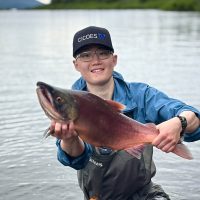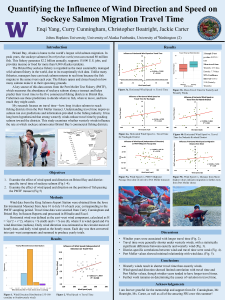
Enqi Yang
Johns Hopkins University
Research Mentor: Daniel Schindler, Curry Cunningham
Project: Quantifying the Influence of Wind Direction and Speed on Sockeye Salmon Migration Travel Time
Greetings everyone! My name is Enqi Yang, and I would like to extend my deepest gratitude to Dr. Cunningham, Ms. Carter, Mr. Boatright, and Mr. Selmont. Because of your generosity, I was able to witness the largest sockeye salmon migration in the world. I observed the arrival of tens of thousands of salmon while they were still silver, and then, within just two weeks, they transformed into their brilliant cherry-red spawning color. The salmon then swam into the myriad of creeks to eventually spawn where they were born. It’s absolutely remarkable that the salmon return to spawn in the very place of their birth! To achieve this, they navigate thousands of miles in the ocean, somehow knowing how far they are from the lake, adjusting their swimming speed to calculate their arrival, and avoiding the wrong channels and rivers. I developed a profound sense of awe for this extraordinary creation.
This summer, the main part of my internship focused on field data collection across all life stages of sockeye salmon (Oncorhynchus nerka). At the base of food chain, we performed weekly limnology surveys, pulling in zooplankton from 60m depths and collecting water chlorophyll samples. For salmon fry, we conducted weekly beach seines to measure relative abundance of sockeye salmon alongside other species such as stickleback, char, and smelt. For out-migrating juveniles (smolt), we set smolt traps every other night to collect size and abundance data. For adult salmon, we gathered genetic samples through fin clipping, conducted stream surveys to estimate the number of spawners and mortalities, and recorded how far they traveled upriver. There was around 8 different streams we surveyed on a weekly basis. We also performed scarring survey, by catching salmon and recording how severe they have been scarred from gill nets. This was definitely my favorite field work, as I got to wrestle hand-to-fin with these beasts.
The second part of my project centered on computer-based analysis to determine whether wind influences salmon travel time—the length of time it takes salmon to reach fishing districts from the Port Moller transect. Understanding travel time improves run size predictions and provides more accurate information to the fishing industry. Using RStudio, I found that windier years were associated with longer travel times. Travel times were generally shorter under westerly winds, with a statistically significant difference between easterly and westerly winds.
This summer experience developed a sense of peace and a responsibility to cherish and preserve such natural resources to ensure that future generations will have the right to witness such beauty. At present, I plan to apply for graduate school to become a tuna fisheries stock assessor, quantifying tuna populations in the ocean to inform sustainable harvesting policy.

